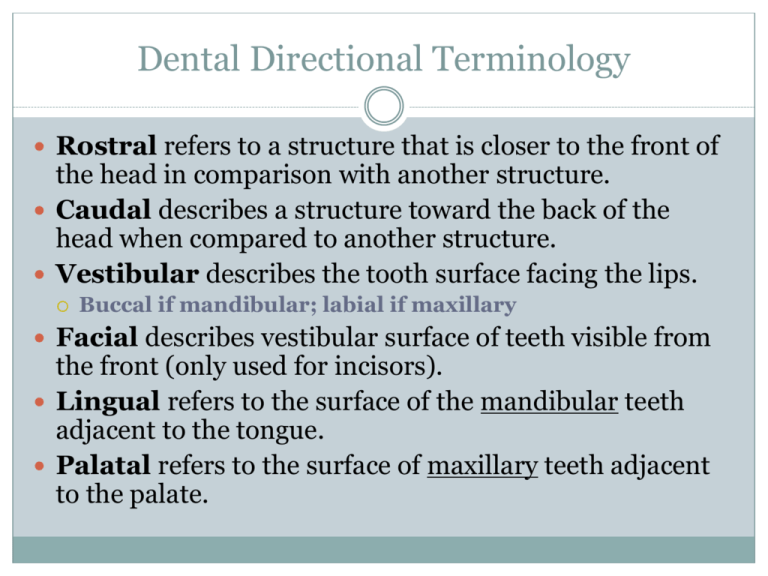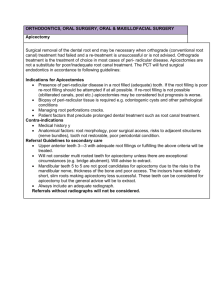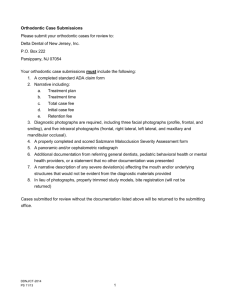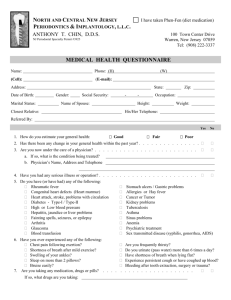Applied Dentistry for the Veterinary Technician
advertisement

Dental Directional Terminology Rostral refers to a structure that is closer to the front of the head in comparison with another structure. Caudal describes a structure toward the back of the head when compared to another structure. Vestibular describes the tooth surface facing the lips. Buccal if mandibular; labial if maxillary Facial describes vestibular surface of teeth visible from the front (only used for incisors). Lingual refers to the surface of the mandibular teeth adjacent to the tongue. Palatal refers to the surface of maxillary teeth adjacent to the palate. Dental Terminology Mesial refers to the portion of the tooth in line with the dental arcade that is closest to the most rostral portion of the midline of the dental arch. Distal refers to the portion of the tooth that is closest to the most caudal portion of the midline of the dental arch. Apical refers to a portion of the tooth closer to the apex, or tip of the root. Coronal refers to a structure within a location closer to the crown of the tooth in relation to another structure. Occlusal refers to the part of a tooth that meets with, or occludes with, the teeth of the opposite dental arcade. Interdental space refers to the space between each individual tooth. A palatal view of the dog maxilla. The midline is marked with a line, and the mesial and distal tooth surfaces are marked with an M or D. Occlusion Orthodontics studies the way in which the teeth meet each other (occlude). Occlusion is defined as the normal position of the teeth when the jaws are closed. In normal occlusion, teeth come together in a scissors bite. The mandibular canine tooth resides in the interdental space of the upper third incisor and the upper canine tooth. The upper fourth premolar tooth overlaps the lower first molar, which together, constitute the carnassial teeth. Normal Occlusion Normal scissors occlusion in a dog: Rostral view of incisors and canine teeth Normal Scissors Occlusion: Lateral view of a dog skull. Premolars interdigitate toward the opposing interdental space. Review: Can You Name These Structures? Malocclusion Malocclusion is an abnormality in the position of the teeth. It can occur in any of the three head shapes, but is more common in brachycephalic breeds. It is more common in dogs but also occurs in cats. There are four classes of malocclusions. (Class I, II, III, and IV) Class I- easily fixed with orthodontic correction Class II-IV are skeletal malocclusions due to differing jaw length Class I: Rostral Cross-bite Maxillary incisors are caudal to the mandibular incisors. Very common malocclusion in veterinary dentistry. Thought to occur secondary to retained deciduous incisors. Treatment consists of orthodontic movement or extraction of the abnormal teeth. Treat vs. not treat? Rostral Cross-bite Caudal Cross-bite Maxillary premolars/molars are positioned lingual to the mandibular opposing premolars/molars Occurs occasionally in dolichocephalic breeds. More frequent professional prophylaxis will be needed for these pets. Caudal Cross-bite The maxillary fourth premolar is positioned abnormally inside of the lower first molar tooth. This condition did not require treatment as the pet had a comfortable and functional occlusion (bite). Class II: Mandibular Distoclusion Mandibular brachygnathism: abnormally short mandible, normal maxilla Note: this may also be due to maxillary prognathism (abnormally long maxilla) Referred to as “overshot” Lack of self-cleaning ability and can create painful palate abrasions. Not an accepted standard in any breed. Maxilla is longer than the mandible. Mandible is longer than the maxilla. Class III: Mandibular Mesioclussion Mandibular prognathism: abnormally long mandible, normal length maxilla Note: Could also be maxillary brachygnathism (not common) Referred to as “undershot” These dogs will lose some of their self-cleaning ability and trap plaque and debris more easily. Maxillary incisors can traumatize the mandible. Accepted as normal in brachycephalic breeds such as Bulldogs, Pekingese, Boston terriers, Pugs, and Persian cats. Mandibular Prognathism Mandible is longer than the maxilla. Wry Mouth Each upper and lower right and left quadrant of the mouth is independent of the other, resulting in uneven growth which produces a wry occlusion (wry bite). In its mildest form, a one-sided prognathic or brachygnathic bite forms. In more severe cases, a crooked head and bite develop. A triangular opening (open bite) will also appear in the incisor area where the affected incisors do not meet. In severe cases, the tongue protrudes from the open bite. Wry Mouth: One quadrant develops unevenly from the other quadrants Persistent Deciduous Teeth Interfere with normal eruption pathway of permanent teeth malocclusion Are a reservoir for debris dental disease Early detection is key! Common in small breed dogs Extraction is almost always necessary Referred to as Interceptive Orthodontics Persistent Deciduous Teeth Most permanent teeth will erupt lingual or palatal to the deciduous teeth. (babies in front) Exception: Permanent maxillary canine teeth will erupt rostral/mesial to the deciduous canine teeth. *Why is this significant? Persistent Deciduous Canine Teeth Abnormal attrition Polydontia Supernumerary teeth should not be confused with retained deciduous teeth. Radiographs aid in differentiation. How? Occurs in about 10% of dogs and rarely in cats. Unless extra tooth causes crowding, no treatment is necessary. Occasionally the extra teeth will erupt in an abnormal angle or be impacted. If crowding increased chance of periodontal disease. (Extraction necessary) Supernumerary Teeth Deciduous or Permanent? Oligodontia Also called hypodontia One or more teeth (usually incisors or premolars) do not form in the dental arcade. Many breeds are affected. Unerrupted or hypodontia? If permanent tooth is absent, a baby tooth will often remain in the arch for months to years. No treatment; usually does not cause any problems.







